Serial numbers
Purpose of recording serial numbers
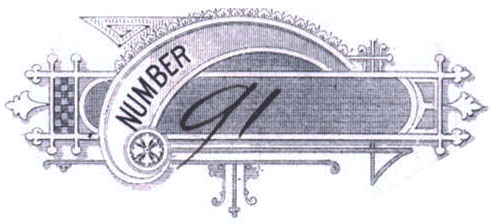
I record serial numbers as I record prices, issuance and cancellation conditions, and contributors. Serial numbers allow the ability to:
- better estimate availability of varieties
- better estimate the frequency of appearances of varieties
Serial number order
As mentioned elsewhere on this website, I have never discovered an inviolable rule concerning stocks and bonds. That is why I use words like "generally" and "usually" so often. For instance, companies generally numbered their stock certificates in ascending order starting at #1. In doing so, serial numbers within any given series should increase as in date order. BUT, there are exceptions.
If companies issued multiple types of stock certificates and multiple denominations, then there might be several streams of serial numbers ticking ever-upward with corresponding dates. For instance, a company might have issued two types of stock during the same time period: common and preferred. If each type were represented by <100-share, 100-share, and odd-share denominations, then each denomination would have been numbered separately. Such a company might have had six entirely separate sets of serial numbers, all starting at #1 and ascending at different rates.
Bonds were numbered similarly. Each series of bonds generally had their own sets of serial numbers starting at #1 and ascending to the maximum number of bonds authorized. Unlike stock certificates, many coupon bonds were numbered from #1 upward through all denominations. This is especially true with earlier bonds. For instance, a company might have issued:
- two hundred $1,000 bonds numbered from #1 to #200
- one hundred $500 bonds numbered from #201 to #300
- one hundred $100 bonds numbered from #301 to #400.
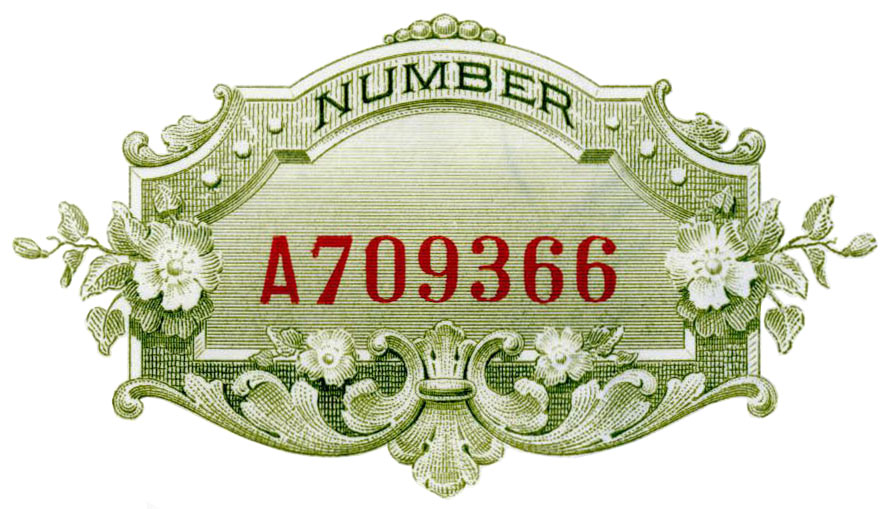
Larger companies often issued several series of bonds consisting of both coupon bonds and registered bonds. In those cases, coupon bonds were usually issued in a single $1,000 denomination starting at #1. Serial numbering among the various denominations of registered bonds usually started at #1, with unique letter prefixes for each denomination. For instance, $1,000 bonds would have been numbered starting at #M1, $5,000s at #V1, $10,000s at #X1, etc. Registered bonds often had a series of "odd" denomination bonds, issuable in units of $1,000 and numbered with some other letter prefix
More elaborate prefixes were necessary among the very largest companies that sold hundreds of thousands of stock certificates and hundreds of thousands of bonds. Serial number prefixes sometimes correlated with place of issuance such as "P" for Philadelphia, "N" for New York and "C" for Chicago. And of course, there are several cases where serial number prefixes remain entirely mysterious.
Odd serial number order
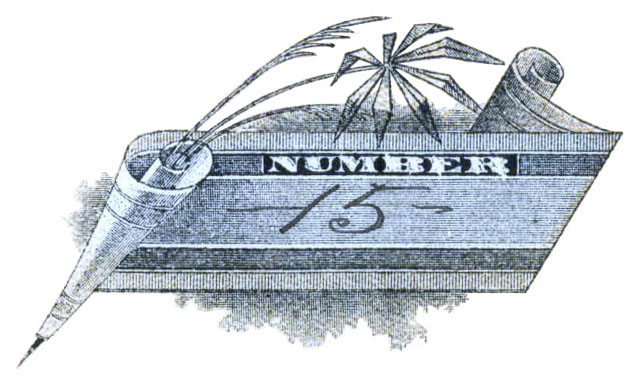
Not surprisingly, there are examples of serial numbering where logical order fails.
It appears that some companies, especially early companies, recycled serial numbers. For instance, stock certificate #23 might have been sold in 1840 and another #23 was sold out of the same stock certificate series in 1844. It appears some companies issued new certificates with old serial numbers whenever shares were transferred to new investors.
I have seen some series of stock certificates where number-only serial numbering appeared to ascend in ordinary date order, but with occasional prefix or suffix letters thrown in. For instance, I might have records of certificates arrayed in date order something like #4, #7, #8, #10, #A3, #14, #A9. It is often unclear what the "A"s meant. The might have been recycled numbers. They might have been issued in different places. They might have been special in some way.
There are also cases where serial numbers are unique but issued out of date order. In other words, records might show that #3, #5, and #9 were issued in May, 1850 and #4 in August, 1850. Why was #4 issued after #9? Perhaps number #4 had been sold, but not paid for by an important friend of the company vacationing in Europe. Or maybe it was simply a recycled serial number that had been issued and transferred. Matters would probably be clearer if all issued serial numbers were known.
Serial numbers that span denominations
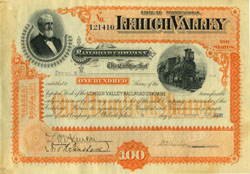
Companies that used multiple pre-printed denominations on their stock certificates normally had engravers print large numbers of <100-share and 100-share denominations and fewer certificates of intermediate denominations such as 1-share, 5-share, 10-share, 25-share, and 50-share certificates. In general, each denomination had its own set of pre-printed serial numbers, usually with unique prefixes. If prefixes were not used, then each denomination normally had its own unique range of serial numbers.
- 5-share from 2000 to 3999
- 10-share from 10000 to 14000, etc.
The Lehigh Valley Railroad Co. is unusual in that it used a series of certificates printed with nineteen different denominations in three colors, all with the same general design. Each denomination had one of three colored borders. However, each denomination had separate custom-engraved borders that contained small engraved denominations in different repeating patterns. This series of Lehigh Valley Railroad certificates is made even more unusual in that serial numbers were not pre-printed.
Instead, the company printed serial numbers as it issued certificates. If all certificates of this series existed, and were known, serial numbers would form a continuous range of about 73,000 numbers that would parallel dates but span denominations. Only two other companies are known that share this type of numbering: the West Jersey & Seashore Railroad Co and the Pennsylvania Rail Road Co. Speculation about the West Jersey and Seashore is unconfirmed because there are an insufficient number of certificate images available for analysis.
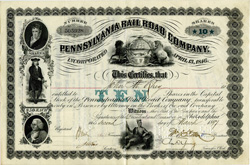
Analysis positively supports the notion that the Pennsylvania Railroad did the same thing as the Lehigh Valley, except that it issued many more than a mere nineteen variations.
For three decades, I had assumed American Bank Note Company had printed a series of certificates (shown at right) with normal pre-printed serial numbers. You will notice a green "10" is visible in the share medallion at the top right and a bold "TEN" printed on the front. There is also "TEN" printed in reverse on the back. I had further assumed that the railroad had overprinted the "10/TEN" denominations at the time of issuance. (Image courtesy of Robert Warchocki.)
In October, 2021, while recording sale prices from auction 120 of the German auction house Freunde Historischer Wertpapiere (FHW), I noticed it offered 33 lots of these certificates, all separately. It had offered the series as if each denominations was different. Although, only four lots had sold, prices were abnormally strong ($116 to $173 US). I found that curious.
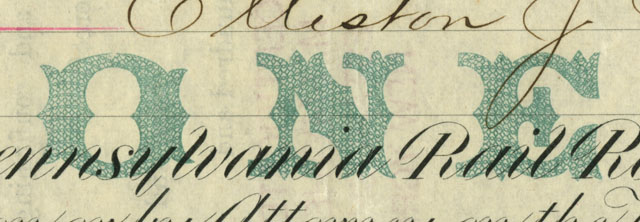
I did not own any those certificates at the time, so I examined high-resolution images sent by a long-time contributor. I contacted him and asked him to re-examine his certificates. He confirmed that the green denominations had been printed BEFORE the black text, vignette and border. Not only that, but the bold verbal denominations ("TEN" and the reversed "NET") on the back were printed in perfect registration, front and back. That would have been impossible had ABNCo used separate plates..
Since then, I have acquired several certificates and can absolutely confirm the black plate was printed after the green denominations. Furthermore, my records of serial numbers clearly confirm that serial numbers, like those of the Lehigh Valley, parallel dates and cross denominations.
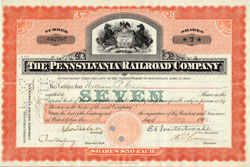
This series of Pennsylvania Rail Road certificates can be found with three pre-printed date variations: '18--', '190-' and '19--.' That means there are at least 300 (!) possible sub-varieties of this same design. I do not expect anyone to try to collect all 300, so I have not created separate variety numbers. The Pennsylvania's certificates are NOT common.
But wait...there's more!
A later series of Pennsylvania Railroad stocks certificates (at right) were printed and issued in the same manner with serial numbers crossing denominations. Certificates from this serials are substantially scarcer than the earlier series, so my knowledge is very limited. I need help understanding more about this series.
Low serial numbers
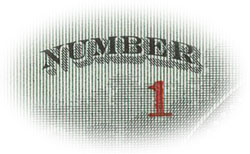
Since inception of the hobby, experienced collectors have sought out certificates with serial #1. They have common premiums of 25% to 75% for their efforts.
Amateur sellers on eBay frequently promote "low" serial numbers (often in the hundreds) hoping to bump up the price of dreadfully common certificates. They are wasting their time.
I have occasionally recorded small premiums paid for serials #2 and #3, but none for higher serial numbers. I have encountered a couple collectors who wanted specific serial numbers, but if they were paying premiums, the amounts were insignificant when compared to the highly flexible range of prices paid for certificates across various markets.
As mentioned before, every issue of bearer bonds had (at least to my knowledge) only one number #1 certificate. If a company sold registered bonds, then there were usually several #1s with different serial prefixes. Unfortunately, I know some collectors are looking for #1s among varieties that never had any #1s at all. Take for instance the nineteen Lehigh Railroad varieties of stock certificates mentioned above. The lowest serial number ever issued for ANY denomination in that series was probably around #85,000 because numbering had continued unbroken from earlier certificate designs. Even if companies issued several different variations of stock certificates, there often was only one #1 stock certificate per company, or per certificate series.
Accuracy of recorded numbers
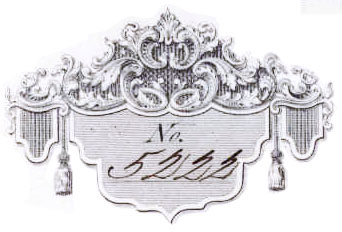
The online database is available to all users and shows every serial number recorded up to the time of the last update, usually no more than 15 days before. Numbers are as accurate as possible, but mistakes are inevitable:
- handwritten serial numbers are frequently terribly hard to read
- handwritten serial numbers can be mis-interpreted
- serial numbers have been reported by collectors and dealers without images for proof
- some sources are notorious for reporting serial numbers and dates that cannot possibly fit into existing and provable series of serial numbers' in those cases, both dates and serial numbers become unreliable
- some sellers persist in using use stock images for illustrations and therefore render reported serial numbers unprovable
I BEG collectors to contribute send scans or photographs of certificates to help fill out the database further, no matter how common their certificates might be.